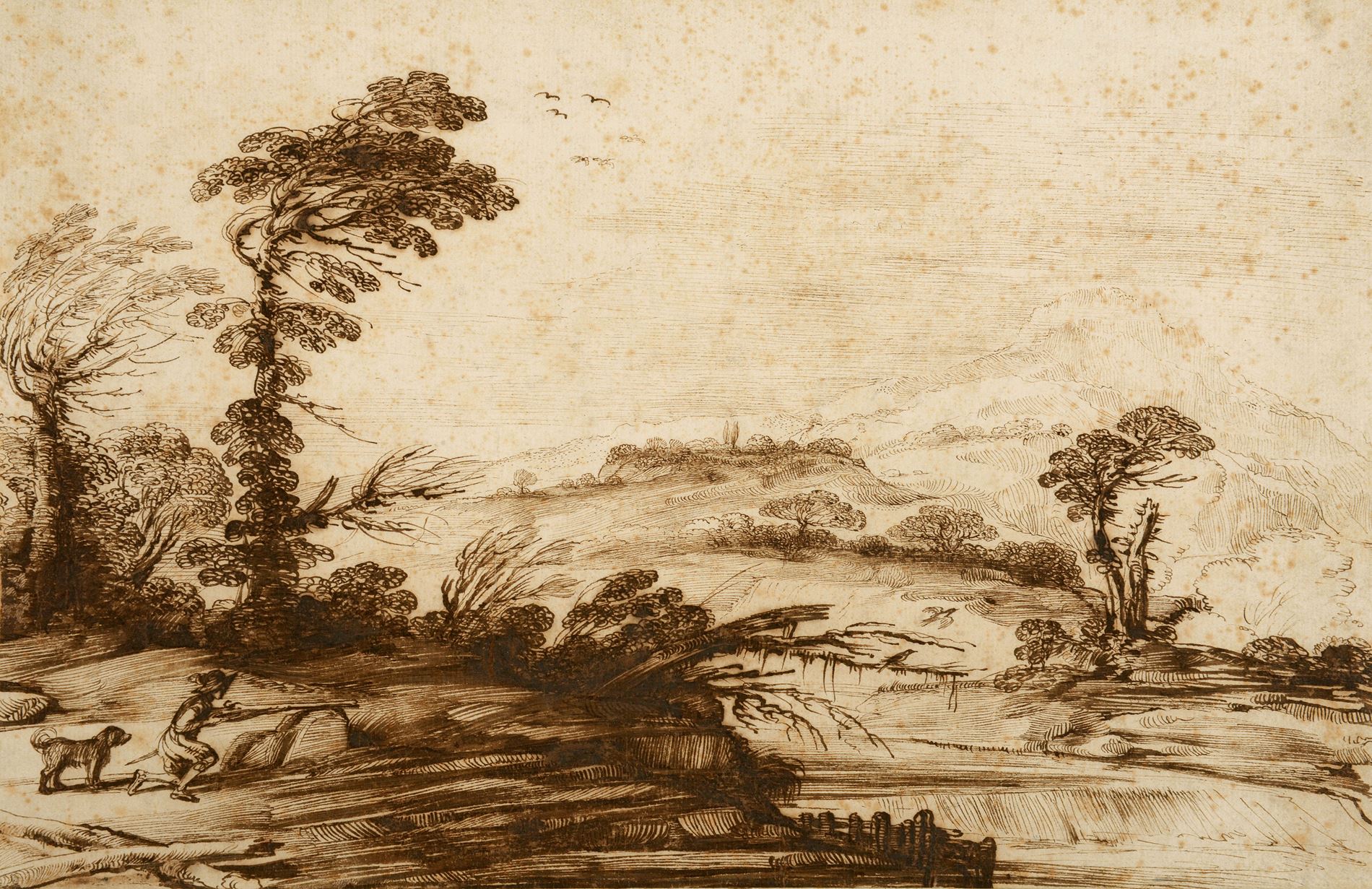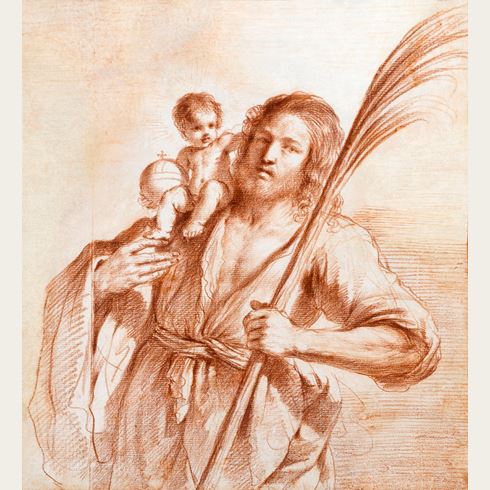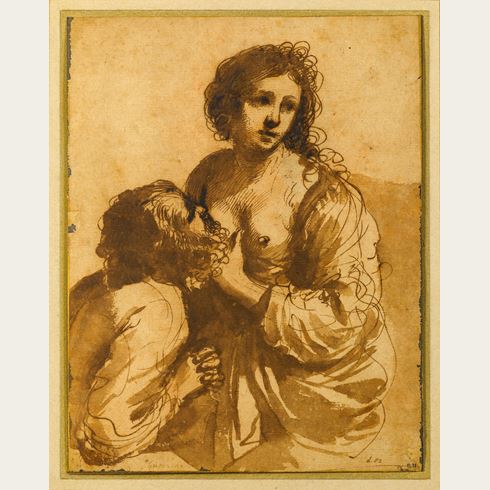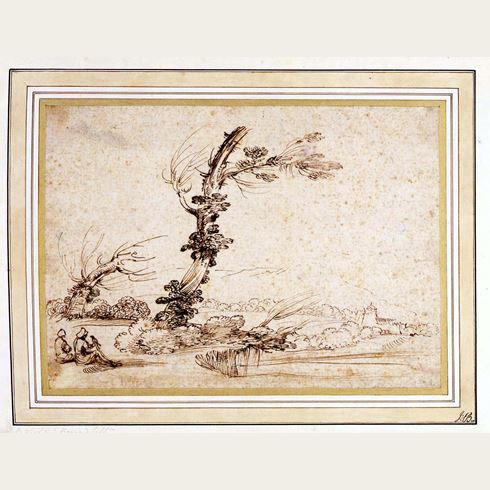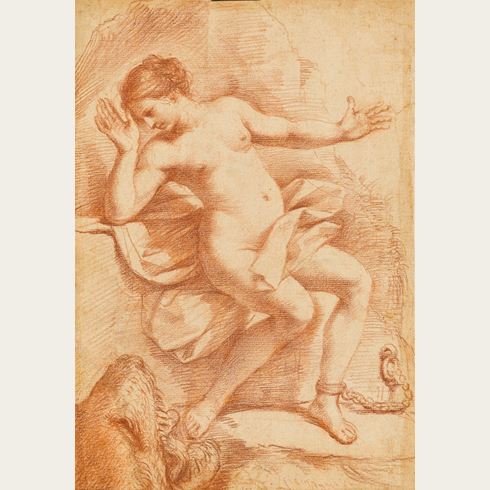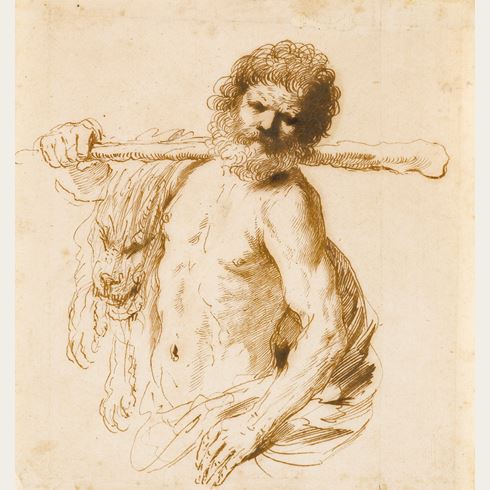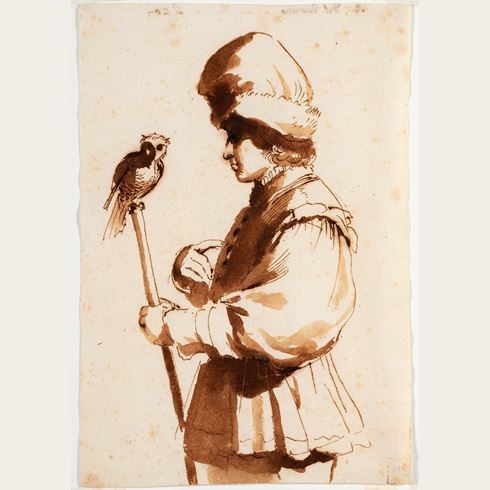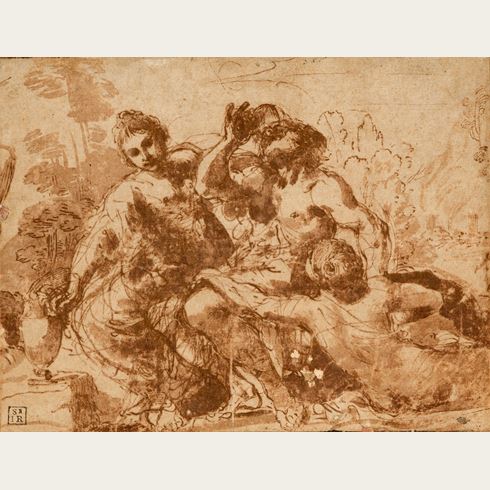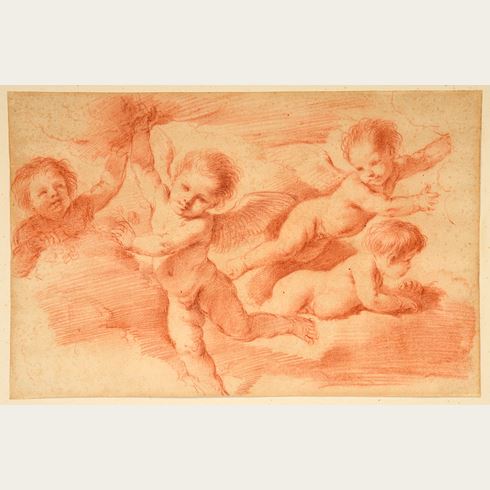Giovanni Francesco Barbieri GUERCINO
(Cento 1591 - Bologna 1666)
River Landscape with a Hunter and his Dog
Inscribed (in a modern hand) Guercino / da Cento and numbered 1.8 on the verso.
Further inscribed (with mountmaker’s notes?) in German on the verso.
240 x 371 mm. (9 1/2 x 14 5/8 in.)
As early as about 1674 a series of fourteen landscape drawings by Guercino, all of which were until recently in the collection of the Dukes of Devonshire at Chatsworth, were sent by the artist’s nephew and pupil Cesare Gennari to Paris, to be engraved by the printmaker Jean Pesne. These were published a few years later in Italy, accompanied by a frontispiece designed by Gennari. Guercino’s landscapes continued to be greatly admired well into the 18th century, and the largest surviving group of them, numbering some thirty sheets, is today in the Royal Library at Windsor Castle. These drawings were acquired from the artist’s heirs, in the late 1750s and 1760s, by King George III’s Librarian, Richard Dalton.
The present sheet is a very fine and characteristic example of Guercino’s landscape drawings. A sense of spatial recession is achieved by the artist’s use of the pen, with darker and thicker strokes of ink in such prominent foreground elements as the trees at the left becoming progressively lighter and more delicate as the eye moves through the landscape towards the mountains in the far distance. Also typical of the artist is the figure of the hunter, which adds a vital human element to the finished composition.
This drawing was almost certainly part of the large and important group of drawings by Guercino that belonged to the artist’s nephews and heirs in Bologna, the painters Benedetto and Cesare Gennari. The Gennari owned nearly 5,300 drawings by Guercino, divided between their home in Bologna and the family villa at Bel Poggio, outside the city. While some of these drawings were displayed in frames (though usually not behind glass), the vast majority were either pasted into a series of large albums or kept as loose sheets in folios. According to the Bolognese biographer Carlo Cesare Malvasia, the Gennari collection included ‘Ten volumes of drawings, some in pen, some in red and black chalk, with a variety of exquisitely drawn landscapes’. In the inventory of the Casa Gennari, drawn up in October 1719, several albums of drawings by Guercino are listed, one of which contained ninety-two landscapes (‘Dissegni à Penna ed’ Acquarella rapresentanti vedute di Paesi diversi’). Of the two hundred landscape drawings by Guercino listed in the 1719 Gennari inventory, five were valued very highly, at twenty-five lire each, while some thirty landscapes were framed and displayed on the walls of the Casa Gennari in Bologna or the country villa at Bel Poggio.
More recently, the present sheet was one of a number of very fine Guercino drawings in the collection of the Italian scholar and art historian Prisco Bagni (1921-1995), a native of Cento who published several important studies on Guercino and his studio, as well as on the Gandolfi family of artists. Bagni lent this drawing to the important exhibition of Guercino drawings held in Bologna in 1991, on the four hundredth anniversary of the artist’s birth.
Giovanni Francesco Barbieri, known as Il Guercino (‘the squinter’) because he was cross-eyed, was by the second decade of the 17th century one of the leading painters in the province of Emilia. Born in Cento, a small town between Bologna and Ferrara, Guercino was largely self-taught, although his early work was strongly influenced by the paintings of Ludovico Carracci. In 1617 he was summoned to Bologna by Alessandro Ludovisi, the Cardinal Archbishop of Bologna, and there painted a number of important altarpieces, typified by the Saint William Receiving the Monastic Habit, painted in 1620 and now in the Pinacoteca Nazionale in Bologna. When Ludovisi was elected Pope Gregory XV in 1621, Guercino was summoned to Rome to work for the pontiff and his nephew, Cardinal Ludovico Ludovisi. It was in Rome that Guercino painted some of his most celebrated works, notably the ceiling fresco of Aurora in the Casino Ludovisi and the large altarpiece of The Burial and Reception into Heaven of Saint Petronilla for an altar in Saint Peter’s. The papacy of Gregory XV was short-lived, however, and on the death of the Pope in 1623 Guercino returned to his native Cento. He remained working in Cento for twenty years, though he continued to receive commissions from patrons throughout Italy and beyond, and turned down offers of employment at the royal courts in London and Paris. Following the death of Guido Reni in 1642, Guercino moved his studio to Bologna, where he received commissions for religious pictures of the sort that Reni had specialized in, and soon inherited his position as the leading painter in the city.
Guercino was among the most prolific draughtsmen of the 17th century in Italy, and his preferred medium was pen and brown ink, although he also worked in red chalk, black chalk, and charcoal. He appears to have assiduously kept his drawings throughout his long career, and to have only parted with a few of them. Indeed, more drawings by him survive today than by any other Italian artist of the period. On his death in 1666 all of the numerous surviving sheets in his studio passed to his nephews and heirs, the painters Benedetto and Cesare Gennari, known as the ‘Casa Gennari’.
The drawings of Guercino, which include figural and compositional studies, landscapes, caricatures and genre scenes, have always been coveted by later collectors and connoisseurs. Indeed, the 18th century amateur Pierre-Jean Mariette noted of the artist that ‘Ce peintre a outre cela une plume tout-à-faite séduisante’. The largest extant group of drawings by Guercino is today in the Royal Collection at Windsor Castle; these were acquired from the Gennari family by King George III’s librarian, Richard Dalton, between about 1758 and 1764.
Provenance
Possibly Francesco Forni, Bologna
Private collection, Austria
Prisco Bagni, Milan
Thence by descent.
Literature
Exhibition

